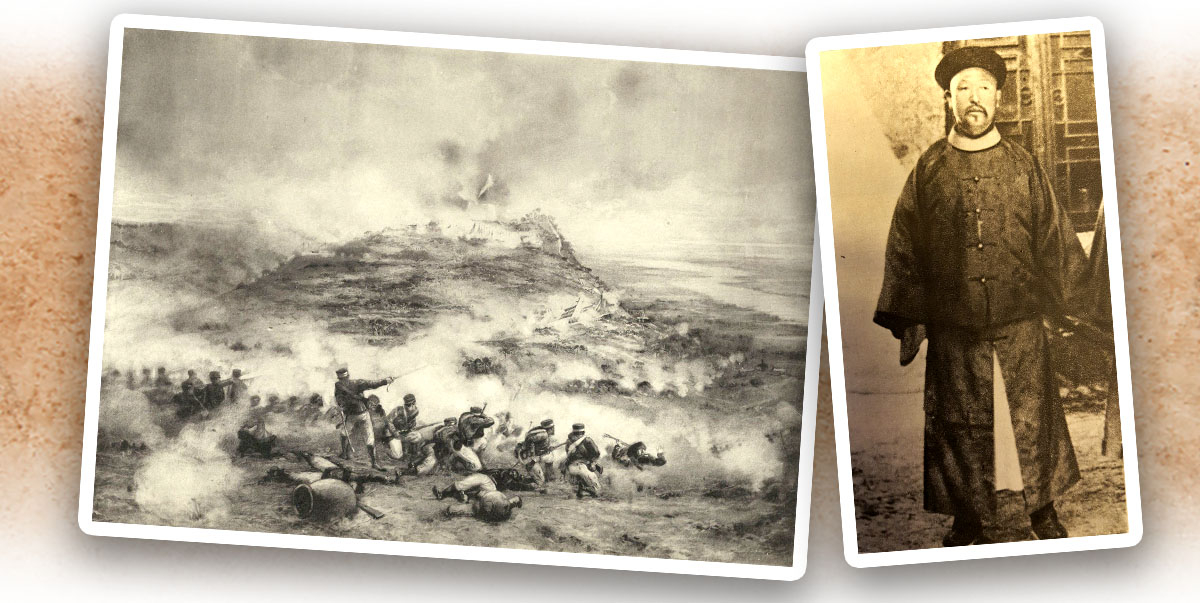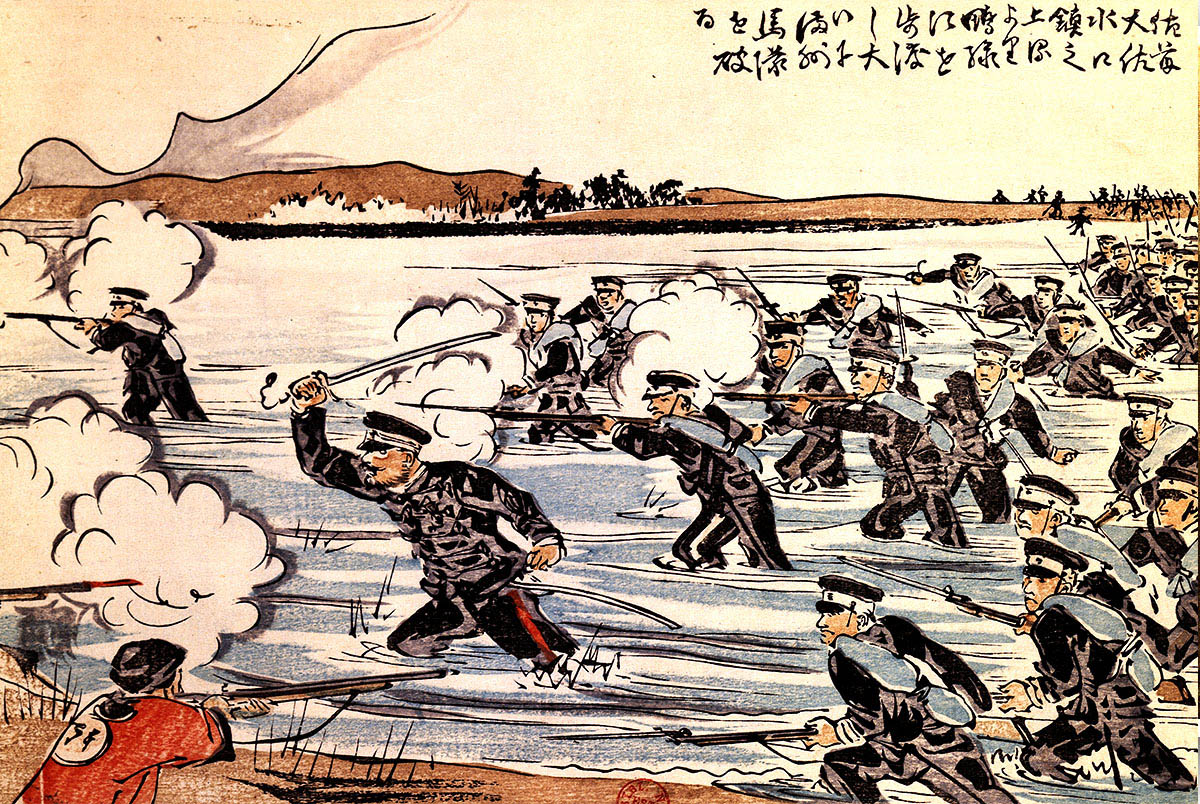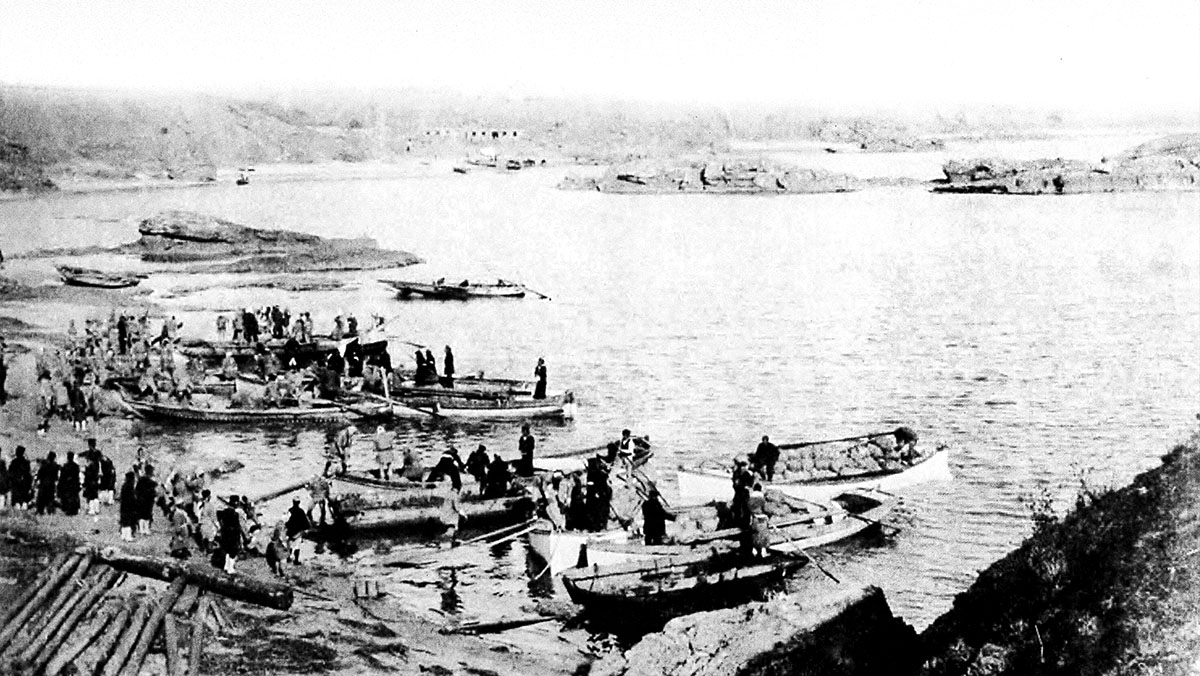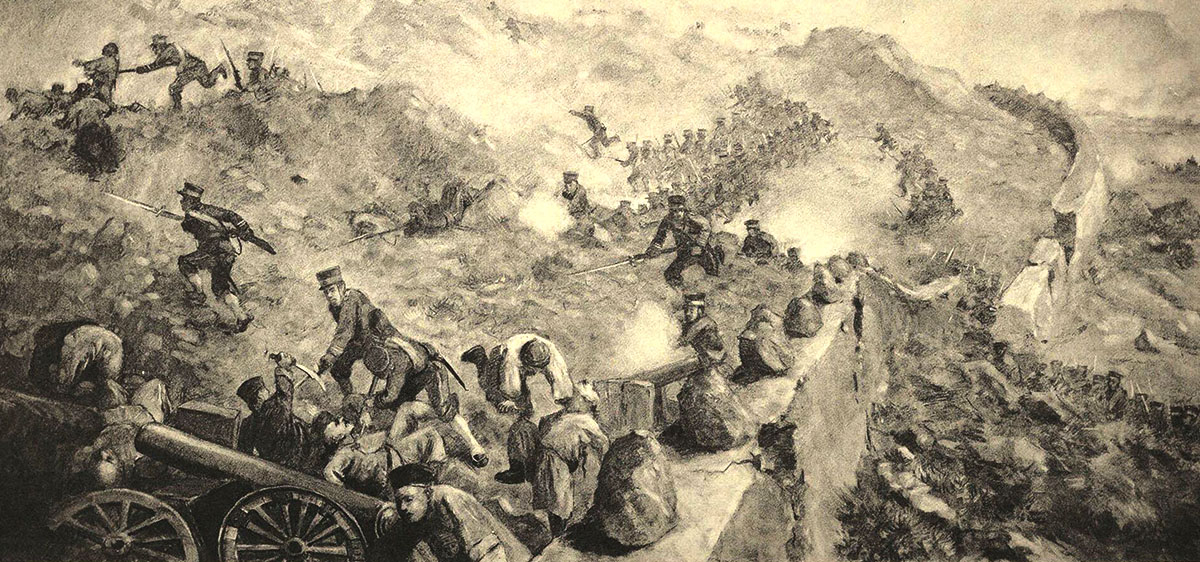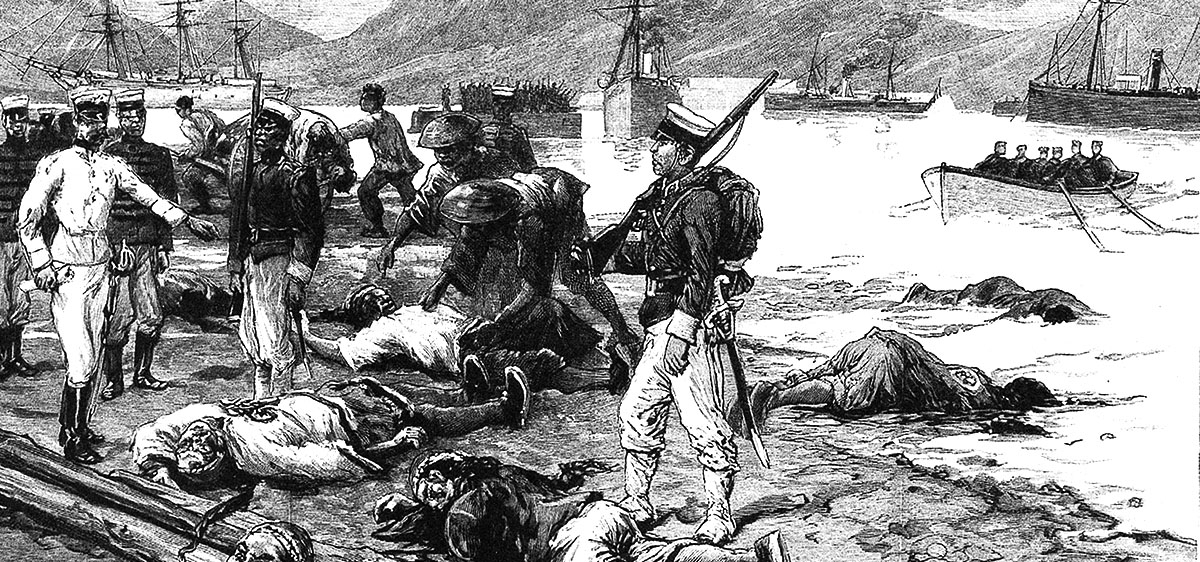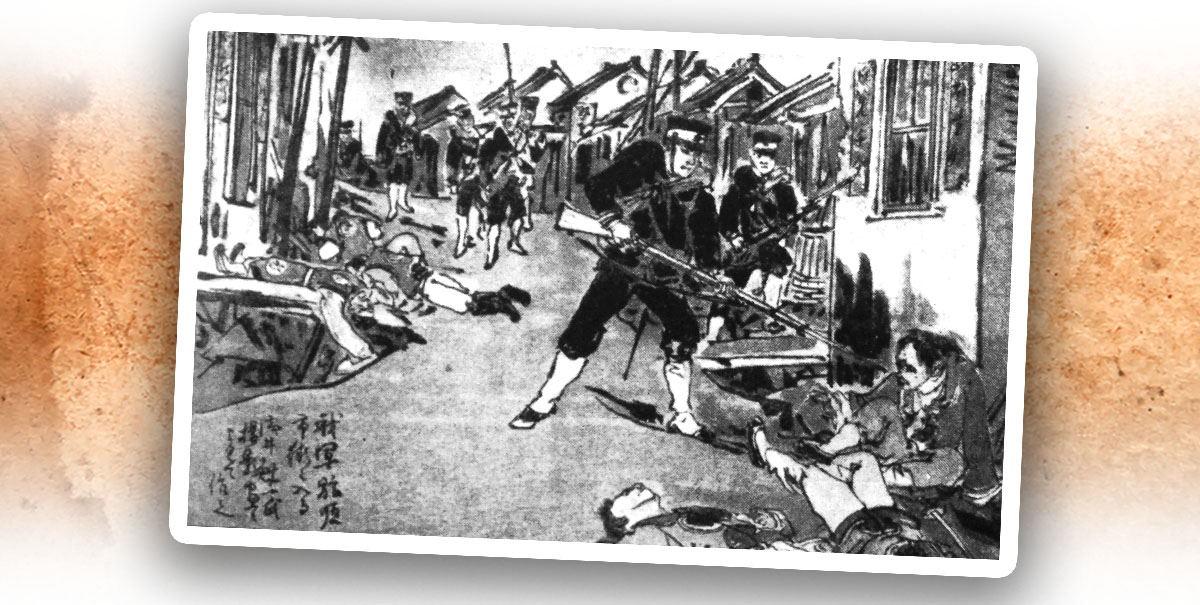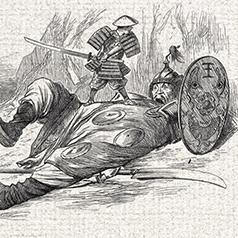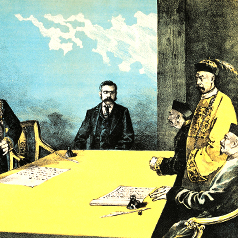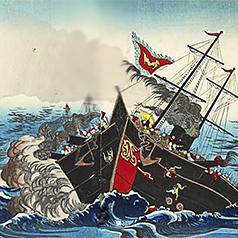The armed forces of China and Japan had learned from the West and embarked on modernization programs by the time of the First Sino-Japanese War. The Chinese and Japanese forces were comparable in terms of strength and size, but they were different in terms of their strategy and tactics as well as their determination on the battlefield. When the war began in July 1894, battles were fought on the Korean Peninsula; in September, the Japanese army attacked Pyongyang where Chinese Governor-General Li Hongzhang (李鴻章) took a “wait-and-see” approach to warfare. As a result, General Zuo Baogui (左寶貴) was killed in action and Commander Ye Zhichao (葉志超) abandoned the city. The Qing navy also suffered huge losses in the Battle of the Yellow Sea.
From mid-September, the war continued on the Liaodong Peninsula (遼東半島) in China. As the Japanese broke through the Yalu River (鴨綠江), Chinese territories including Jiuliancheng (九連城), Anton (安東), Dadonggou (大東溝) and Fenghuangcheng (鳳凰城) were quickly captured. Starting in November, other places such as Jinzhou (金州), Dalian (大連) and Lushun (旅順, Port Arthur) were also invaded; more than 20,000 civilians died in the Massacre of Lushun. Between November 1894 and March 1895, the Shandong Peninsula (山東半島) came under Japanese land and naval attack. Besides taking the naval base in Weihaiwei (威海衛), Japanese forces occupied Niuzhuang (牛莊) and Yingkou (營口) through Haicheng (海城). At this point, China completely lost control of the east bank of the Liao River (遼河) in an inevitable defeat.
|
|
How did Japan win – and China lose – in the First Sino-Japanese War when Japan had to mobilize from a distance while China had home advantage? |
|
|
See answer below. |
After the Battle of Seonghwan in July 1894, Qing forces broke and retreated to Pyongyang, where they took up defensive positions as the Japanese army prepared for another attack. After the official declaration of war on August 1, both sides continued to bring in reinforcements. Ye Zhichao, the stout figure in the middle of the picture, commanded China’s forces in Korea during the Sino-Japanese War. The picture on the right shows Ōyama Iwao, Japan’s Misister of the Army and commander-in-chief of the Second Army.
From September 12 to 15, 1894, the Japanese army launched a powerful assault on Pyongyang. Zuo Baogui, the Chinese commander, was killed in action but the Chinese Commander-in-Chief, Ye Zhichao, abandoned the city and fled. Pyongyang fell to Japanese forces that night. The pictures above depict the battle of Pyongyang and Zuo Baogui respectively.
The Japanese army continued to press north after its Pyongyang victory and successfully crossed the Yalu River (the border between Korea and China) on September 25, 1894, in effect gaining control over the entire Korean Peninsula.
On October 30, 1894, the Japanese landed at Huayuankou (花園口), Liaodong Peninsula. While China and Japan were engaged in battle on land, the two countries’ naval forces also fought a decisive battle in the Yellow Sea. It too ended in defeat for the Qing forces. With the Chinese forces’ retreat from Korea and loss of control over nearby waters, Japan was able to follow up its victory by invading the Liaodong Peninsula.
On November 6, 1894, the Japanese captured Jinzhou of Liaoning (遼寧). The picture shows Qing soldiers slain in the Battle of Jinzhou.
On November 6, 1894, the Japanese captured Dalian Bay, a strategic location in the Liaodong Peninsula. The picture shows a cannon platform in the center of Japanese-occupied Dalian Bay.
With Dalian Bay taken, the key port Lushun (also known as Port Arthur) became the Japanese army’s next target. In the morning of November 21, 1894, the Japanese army mounted an all-out assault on the cannon batteries located on Mount Yizi (椅子山), Mount Anzi (案子山), Mount Songshu (松樹山), Mount Erlong (二龍山) and Mount Huangjin (黃金山). The picture shows the Japanese siege of the cannon batteries on Mount Erlong.
On November 21, 1894, Lushun fell in less than a day in the face of Japan’s all-out-attack.
Once Lushun had fallen, the defending Qing forces lost all morale and abandoned the city’s civilians to their enemies. They fled, with the Japanese army in hot pursuit.
After the fall of Lushun, more than 20,000 civilians, including women and children, were slaughtered by the Japanese army in a four-day Port Arthur Massacre (also called the Lushun Massacre) that shocked the world. Depictions of the massacre by a Japanese army journalist show the Japanese troops going from home to home, killing Chinese civilians at will. Following the massacre, the Japanese army continued to advance to all regions of Liaodong. By March 1895, they had captured various strategic locations including Niuzhuang (牛莊), Yingkou (營口) and Tianzhuangtai (田莊台) and controlled the entire Liaodong Peninsula. From Korea to Liaodong, they had crushed the Qing army in every land battle.
|
|
How did Japan win – and China lose – in the First Sino-Japanese War when Japan had to mobilize from a distance while China had home advantage? |
|
|
During the Meiji Restoration, Japan learned significantly from the German Army and British Navy. Coupled with the traditional Bushido fighting spirit, it embarked on the path of aggressive militarism. Japan prepared the invasion of China via Korea meticulously. This included strategic planning as well as military training and expansion before striking unannounced. In contrast, China was weakened when its Eight Banners and Green Standard Army disintegrated due to the effects of widespread corruption. It even had to rely on local militias to expel rebels during the Taiping Rebellion. Unprepared for battle, China only declared war in the hope of negotiating a truce, but lost all confidence when its general-in-command fled the battlefield. Moreover, some Qing officials were opposed to fighting and wished for mediation, with the help of foreign powers, further undermining China’s war efforts. |
Source of most photos used in this feature piece: Fotoe (pictures 1, 2, 4, 5, 7-10), Visual China Group (pictures 3, 6), misc. photo sources.






